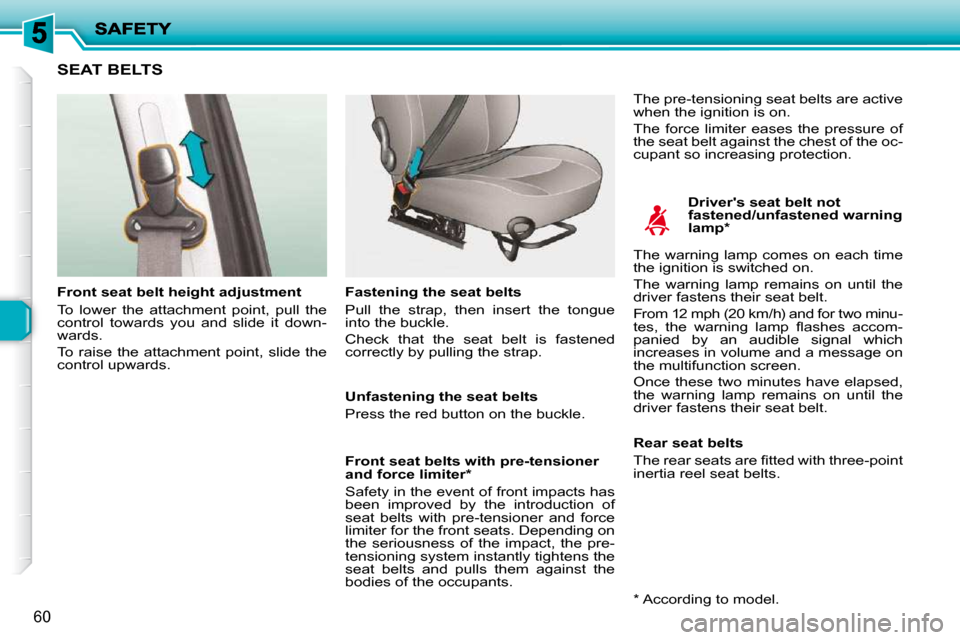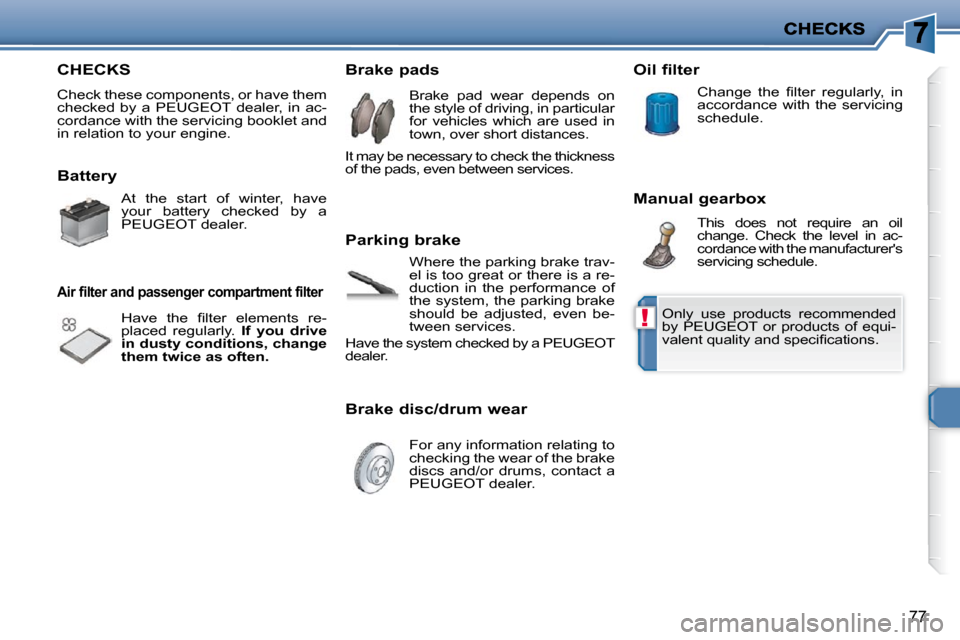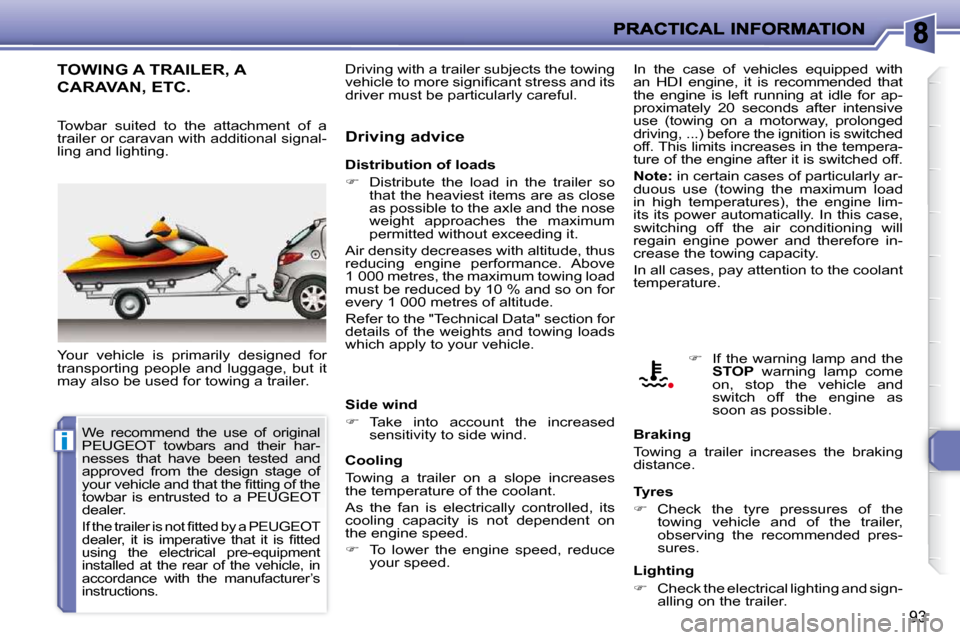tow Peugeot 206 P Dag 2010 User Guide
[x] Cancel search | Manufacturer: PEUGEOT, Model Year: 2010, Model line: 206 P Dag, Model: Peugeot 206 P Dag 2010Pages: 107, PDF Size: 3.94 MB
Page 54 of 107

60
SEAT BELTS
Driver's seat belt not
fastened/unfastened warning
lamp *
Front seat belt height adjustment
To lower the attachment point, pull the
control towards you and slide it down-
wards.
To raise the attachment point, slide the
control upwards. Fastening the seat belts
Pull the strap, then insert the tongue
into the buckle.
Check that the seat belt is fastened
correctly by pulling the strap.
Unfastening the seat belts
Press the red button on the buckle.
Front seat belts with pre-tensioner
and force limiter *
Safety in the event of front impacts has
been improved by the introduction of
seat belts with pre-tensioner and force
limiter for the front seats. Depending on
the seriousness of the impact, the pre-
tensioning system instantly tightens the
seat belts and pulls them against the
bodies of the occupants. Rear seat belts
� �T�h�e� �r�e�a�r� �s�e�a�t�s� �a�r�e� �fi� �t�t�e�d� �w�i�t�h� �t�h�r�e�e�-�p�o�i�n�t�
inertia reel seat belts.
The pre-tensioning seat belts are active
when the ignition is on.
The force limiter eases the pressure of
the seat belt against the chest of the oc-
cupant so increasing protection.
* According to model.
The warning lamp comes on each time
the ignition is switched on.
The warning lamp remains on until the
driver fastens their seat belt.
From 12 mph (20 km/h) and for two minu-
�t�e�s�,� �t�h�e� �w�a�r�n�i�n�g� �l�a�m�p� �fl� �a�s�h�e�s� �a�c�c�o�m�-
panied by an audible signal which
increases in volume and a message on
the multifunction screen.
Once these two minutes have elapsed,
the warning lamp remains on until the
driver fastens their seat belt.
Page 56 of 107

!!
62
AIRBAGS
Front airbags
Impact detection zones
System designed to maximise the safety
of the occupants (with the exception of
the rear centre passenger) in the event
of violent collisions. It supplements the
action of the force-limiting seat belts.
If a collision occurs, the electronic de-
tectors record and analyse the front and
side impacts sustained in the impact
detection zones:
- in the case of a serious impact, the airbags are triggered instantly and
protect the occupants of the vehicle
(with the exception of the rear centre
passenger); immediately after the
�i�m�p�a�c�t�,� �t�h�e� �a�i�r�b�a�g�s� �d�e�fl� �a�t�e� �r�a�p�i�d�l�y�
so that they do not hinder visibility
or the exit of the occupants,
- in the case of a minor or rear impact or in certain roll-over conditions, the
airbags will not be triggered; the
�s�e�a�t� �b�e�l�t� �a�l�o�n�e� �i�s� �s�u�f�fi� �c�i�e�n�t� �t�o� �p�r�o�-
vide optimum protection in these
situations.
The airbags do not operate when
the ignition is switched off.
This equipment will only operate
once. If a second impact occurs (dur-
ing the same or a subsequent acci-
dent), the airbag will not operate.
A. Front impact zone.
B. Side impact zone. System which protects the driver and
front passenger in the event of a seri-
ous front impact to limit the risk of injury
to the head and chest.
� �T�h�e� �a�i�r�b�a�g�s� �a�r�e� �fi� �t�t�e�d� �i�n� �t�h�e� �c�e�n�t�r�e� �o�f�
the steering wheel for the driver and in
the dashboard for the front passenger.
Triggering
They are deployed simultaneously in
the event of a serious front impact ap-
plied to all or part of the front impact
zone
A in the longitudinal centreline of
the vehicle on a horizontal plane direct-
ed from the front towards the rear of the
vehicle.
� �T�h�e� �f�r�o�n�t� �a�i�r�b�a�g� �i�n�fl� �a�t�e�s� �b�e�t�w�e�e�n� �t�h�e�
front occupant of the vehicle and the
dashboard to cushion their forward
movement.
Triggering of the airbag(s) is ac-
companied by a slight emission
of harmless smoke and a noise,
due to the activation of the pyro-
technic cartridge incorporated in
the system.
This smoke is not harmful, but
sensitive individuals may experi-
ence slight irritation.
The noise of the detonation may
result in a slight loss of hearing
for a short time.
Page 63 of 107

!
67
The incorrect installation of a child
seat in a vehicle compromises the
child's protection in the event of an
accident.
Remember to fasten the seat belts
or the child seat harnesses keep-
ing the slack in relation to the
child's body to a minimum , even
for short journeys.
For optimum installation of the "for-
ward facing" child seat, ensure that
the back of the child seat is in con-
tact with the back of the vehicle's
seat and that the head restraint
does not cause any discomfort.
If the head restraint has to be re-
moved, ensure that it is stored or
attached securely to prevent it from
being thrown around the vehicle in
the event of sharp braking.
Children under the age of 10 must
not travel in the "forward facing"
position on the front passenger
seat, unless the rear seats are al-
ready occupied by other children,
cannot be used or are absent. Installing a booster seat
The chest part of the seat belt must
be positioned on the child's shoulder
without touching the neck.
Ensure that the lap part of the seat
belt passes correctly over the child's
thighs.
PEUGEOT recommends the use of
�a� �b�o�o�s�t�e�r� �s�e�a�t� �w�h�i�c�h� �h�a�s� �a� �b�a�c�k�,� �fi� �t�-
ted with a seat belt guide at shoulder
level.
As a safety precaution, do not leave:
- one or more children alone and
unsupervised in a vehicle,
- a child or an animal in a vehicle which is exposed to the sun, with
the windows closed,
- the keys within reach of children inside the vehicle.
To prevent accidental opening of the
doors, use the "Child lock".
Take care not to open the rear win-
dows by more than one third.
To protect young children from the
�r�a�y�s� �o�f� �t�h�e� �s�u�n�,� �fi� �t� �s�i�d�e� �b�l�i�n�d�s� �o�n� �t�h�e�
rear windows.
CHILD LOCK
On each rear door, this prevents open-
ing of the door from the inside.
Turn control 1 an eighth turn (45 degrees)
towards the inside of the vehicle using the
ignition key.
Check that the safety lock is engaged
correctly. The control 1 should no longer
be in the vertical position.
Page 72 of 107

!
77
CHECKS
Check these components, or have them
checked by a PEUGEOT dealer, in ac-
cordance with the servicing booklet and
in relation to your engine.
Battery
Air filter and passenger compartment filter
Brake pads
Parking brake
Brake disc/drum wear Oil filter
Manual gearbox
Only use products recommended
by PEUGEOT or products of equi-
�v�a�l�e�n�t� �q�u�a�l�i�t�y� �a�n�d� �s�p�e�c�i�fi� �c�a�t�i�o�n�s�.� �
At the start of winter, have
your battery checked by a
PEUGEOT dealer.
� �H�a�v�e� �t�h�e� �fi� �l�t�e�r� �e�l�e�m�e�n�t�s� �r�e�-
placed regularly.
If you drive
in dusty conditions, change
them twice as often. Brake pad wear depends on
the style of driving, in particular
for vehicles which are used in
town, over short distances.
It may be necessary to check the thickness
of the pads, even between services.
Where the parking brake trav-
el is too great or there is a re-
duction in the performance of
the system, the parking brake
should be adjusted, even be-
tween services.
Have the system checked by a PEUGEOT
dealer.
For any information relating to
checking the wear of the brake
discs and/or drums, contact a
PEUGEOT dealer. � �C�h�a�n�g�e� �t�h�e� �fi� �l�t�e�r� �r�e�g�u�l�a�r�l�y�,� �i�n�
accordance with the servicing
schedule.
This does not require an oil
change. Check the level in ac-
cordance with the manufacturer's
servicing schedule.
Page 75 of 107

!
80
Fitting the wheel
- Once the wheel is in place, pre-tight-en it lightly using the wheelbrace.
- Fold the jack and remove it.
- Tighten the bolts using the wheel- brace.
� � �-� � �R�e�fi� �t� �t�h�e� �w�h�e�e�l� �t�r�i�m� �s�t�a�r�t�i�n�g� �a�t� �t�h�e� valve passage hole and press with
the palm of the hand. Putting the wheel back in place
- Put the jack storage case back in
the wheel.
- Put the wheel back in the carrier.
- Raise the wheel, then the carrier and reposition the hook.
- Do not forget to retighten the spare wheel carrier retaining bolt fully.
- Stow the wheelbrace. For your safety, always change a
wheel:
- on level, stable and non slip-
pery ground,
- with the parking brake applied, ignition off,
� � �-� � �w�i�t�h� �fi� �r�s�t� �o�r� �r�e�v�e�r�s�e� �g�e�a�r� �e�n�- gaged,
- with the vehicle chocked,
- you must ensure that the oc- cupants get out of the vehicle
and wait in a safe location,
- never go underneath a vehicle raised using a jack (use an
axle stand).
The jack and all of the tools are
�s�p�e�c�i�fi� �c� �t�o� �y�o�u�r� �v�e�h�i�c�l�e�.� �D�o� �n�o�t�
use them for other purposes.
After changing the wheel
- Have the tightening of the bolts and the pressure of the
spare tyre checked as soon
as possible by a PEUGEOT
dealer.
- Have the punctured tyre re- paired and replace it on the
vehicle as soon as possible.
Page 88 of 107

!i
92
ECONOMY MODE FUNCTION
After the engine has stopped, with the
key in the accessories position, certain
functions (windscreen wiper, courtesy
lamps, audio equipment, dipped beam
headlamps, etc.) can only be used for
a maximum cumulative duration of ap-
�p�r�o�x�i�m�a�t�e�l�y� �fi� �f�t�e�e�n� �m�i�n�u�t�e�s�,� �t�o� �p�r�e�v�e�n�t�
discharging of the battery.
� �O�n�c�e� �t�h�e� �fi� �f�t�e�e�n� �m�i�n�u�t�e�s� �a�r�e� �o�v�e�r�,� �t�h�e�
message "Economy mode active" ap-
pears on the multifunction screen and
the active functions are put on standby.
These functions will be reactivated au-
tomatically the next time the vehicle is
used.
To resume the use of these functions
immediately, start the engine and let it
run for a few minutes.
The time available will then be double
the time for which the engine is left run-
ning. However, this time will always be
�b�e�t�w�e�e�n� �fi� �v�e� �a�n�d� �fi� �f�t�e�e�n� �m�i�n�u�t�e�s�.�
� �A� �fl� �a�t� �b�a�t�t�e�r�y� �w�i�l�l� �p�r�e�v�e�n�t� �t�h�e� �e�n�-
gine from starting.
TOWING THE VEHICLE
Procedure for having your vehicle towed.
Towing your vehicle
� On the front bumper, unclip the cover
to gain access to the towing eye.
� Switch on the hazard warning lamps
on the towed vehicle.
� Place the gear lever in neutral. Towing another vehicle
Failure to comply with this special
requirement may result in damage
to certain braking components
and the absence of braking assis-
tance the next time the engine is
started.
Page 89 of 107

i
93
TOWING A TRAILER, A
CARAVAN, ETC.
Your vehicle is primarily designed for
transporting people and luggage, but it
may also be used for towing a trailer. Driving advice
In the case of vehicles equipped with
an HDI engine, it is recommended that
the engine is left running at idle for ap-
proximately 20 seconds after intensive
use (towing on a motorway, prolonged
driving, ...) before the ignition is switched
off. This limits increases in the tempera-
ture of the engine after it is switched off.
Note: in certain cases of particularly ar-
duous use (towing the maximum load
in high temperatures), the engine lim-
its its power automatically. In this case,
switching off the air conditioning will
regain engine power and therefore in-
crease the towing capacity.
In all cases, pay attention to the coolant
temperature.
Distribution of loads
� Distribute the load in the trailer so
that the heaviest items are as close
as possible to the axle and the nose
weight approaches the maximum
permitted without exceeding it.
Air density decreases with altitude, thus
reducing engine performance. Above
1 000 metres, the maximum towing load
must be reduced by 10 % and so on for
every 1 000 metres of altitude.
Refer to the "Technical Data" section for
details of the weights and towing loads
which apply to your vehicle.
Side wind
� Take into account the increased
sensitivity to side wind. Braking
Towing a trailer increases the braking
distance.
Tyres
� Check the tyre pressures of the
towing vehicle and of the trailer,
observing the recommended pres-
sures.
Lighting
� Check the electrical lighting and sign-
alling on the trailer.
� If the warning lamp and the
STOP warning lamp come
on, stop the vehicle and
switch off the engine as
soon as possible.
Towbar suited to the attachment of a
trailer or caravan with additional signal-
ling and lighting.
Cooling
Towing a trailer on a slope increases
the temperature of the coolant.
As the fan is electrically controlled, its
cooling capacity is not dependent on
the engine speed.
� To lower the engine speed, reduce
your speed.
We recommend the use of original
PEUGEOT towbars and their har-
nesses that have been tested and
approved from the design stage of
�y�o�u�r� �v�e�h�i�c�l�e� �a�n�d� �t�h�a�t� �t�h�e� �fi� �t�t�i�n�g� �o�f� �t�h�e�
towbar is entrusted to a PEUGEOT
dealer.
� �I�f� �t�h�e� �t�r�a�i�l�e�r� �i�s� �n�o�t� �fi� �t�t�e�d� �b�y� �a� �P�E�U�G�E�O�T�
�d�e�a�l�e�r�,� �i�t� �i�s� �i�m�p�e�r�a�t�i�v�e� �t�h�a�t� �i�t� �i�s� �fi� �t�t�e�d�
using the electrical pre-equipment
installed at the rear of the vehicle, in
accordance with the manufacturer’s
instructions.
Driving with a trailer subjects the towing
�v�e�h�i�c�l�e� �t�o� �m�o�r�e� �s�i�g�n�i�fi� �c�a�n�t� �s�t�r�e�s�s� �a�n�d� �i�t�s�
driver must be particularly careful.
Page 94 of 107

97
WEIGHTS AND TOWING LOADS (IN KG)
Petrol engines
1.1 litre 60
hp 1.4 litre 75
hp
� �G�e�a�r�b�o�x� Manual
� �K�e�r�b� �w�e�i�g�h�t� 945 952
� �G�r�o�s�s� �v�e�h�i�c�l�e� �w�e�i�g�h�t� �(�G�V�W�)� 1 384 1 421
� �G�r�o�s�s� �t�r�a�i�n� �w�e�i�g�h�t� �(�G�T�W�)� 1 884 2 321
� �U�n�b�r�a�k�e�d� �t�r�a�i�l�e�r� 485 510
� �B�r�a�k�e�d� �t�r�a�i�l�e�r� �*� � �(�w�i�t�h�i�n� �G�T�W� �l�i�m�i�t�)� 750 1 178
� �R�e�c�o�m�m�e�n�d�e�d� �n�o�s�e� �w�e�i�g�h�t� 50 50
� � �*� � �T�h�e� �w�e�i�g�h�t� �o�f� �t�h�e� �b�r�a�k�e�d� �t�r�a�i�l�e�r� �c�a�n� �b�e� �i�n�c�r�e�a�s�e�d�,� �w�i�t �h�i�n� �t�h�e� �G�T�W�,� �i�f� �t�h�e� �G�V�W� �o�f� �t�h�e� �t�o�w�i�n�g� �v�e�h�i�c�l�e� �i�s� �r�e�d�u�c�e�d� �b�y� �a�n� �e�q�u�a�l�
�a�m�o�u�n�t�;� �w�a�r�n�i�n�g�,� �t�o�w�i�n�g� �u�s�i�n�g� �a� �l�i�g�h�t�l�y� �l�o�a�d�e�d� �t�o�w�i�n�g� �v�e �h�i�c�l�e� �m�a�y� �h�a�v�e� �a�n� �a�d�v�e�r�s�e� �e�f�f�e�c�t� �o�n� �i�t�s� �r�o�a�d� �h�o�l�d�i�n�g�.� �
� �T�h�e� �G�T�W� �a�n�d� �t�o�w�i�n�g� �l�o�a�d� �v�a�l�u�e�s� �i�n�d�i�c�a�t�e�d� �a�r�e� �v�a�l�i�d� �u�p� �t �o� �a� �m�a�x�i�m�u�m� �a�l�t�i�t�u�d�e� �o�f� �1� �0�0�0� �m�e�t�r�e�s�;� �t�h�e� �t�o�w�i�n�g� �l�o�a�d� �m�e�n�t�i �o�n�e�d�
�m�u�s�t� �b�e� �r�e�d�u�c�e�d� �b�y� �1�0� �%� �f�o�r� �e�a�c�h� �a�d�d�i�t�i�o�n�a�l� �1� �0�0�0� �m �e�t�r�e�s� �o�f� �a�l�t�i�t�u�d�e�.� �T�h�e� �s�p�e�e�d� �o�f� �a� �t�o�w�i�n�g� �v�e�h�i�c�l�e� �m�u�s�t� �n�o�t� �e�x�c�e�e�d� �6�0� �m�p�h�
�(�1�0�0� �k�m�/�h�)� �(�c�o�m�p�l�y� �w�i�t�h� �t�h�e� �l�e�g�i�s�l�a�t�i�o�n� �i�n� �f�o�r�c�e� �i�n� �y�o�u�r� �c�o�u�n�t�r�y�)�.�
� �H�i�g�h� �e�x�t�e�r�i�o�r� �t�e�m�p�e�r�a�t�u�r�e�s� �m�a�y� �r�e�s�u�l�t� �i�n� �a� �r�e�d�u�c�t�i�o�n� �o�f� �t�h�e� �p�e�r�f �o�r�m�a�n�c�e� �o�f� �t�h�e� �v�e�h�i�c�l�e�.� �T�o� �p�r�o�t�e�c�t� �t�h�e� �e�n�g�i�n�e� �w�h�e�n� �t�h�e� �e�x�t�e�r�i�o�r�
�t�e�m�p�e�r�a�t�u�r�e� �i�s� �a�b�o�v�e� �3�7� �°�C�,� �l�i�m�i�t� �t�h�e� �t�o�w�e�d� �w�e�i�g�h�t�.� �
Page 95 of 107

99
� � �*� � �T�h�e� �w�e�i�g�h�t� �o�f� �t�h�e� �b�r�a�k�e�d� �t�r�a�i�l�e�r� �c�a�n� �b�e� �i�n�c�r�e�a�s�e�d�,� �w�i�t�h�i�n� �t�h�e� �G�T�W�,� �i�f� �t�h�e� �G�V�W� �o�f� �t�h�e� �t�o�w�i�n�g� �v�e�h�i�c�l�e� �i�s� �r�e�d�u�c�e�d� �b�y� �a�n� �e�q�u�a�l�
�a�m�o�u�n�t�;� �w�a�r�n�i�n�g�,� �t�o�w�i�n�g� �u�s�i�n�g� �a� �l�i�g�h�t�l�y� �l�o�a�d�e�d� �t�o�w�i�n�g� �v�e �h�i�c�l�e� �m�a�y� �h�a�v�e� �a�n� �a�d�v�e�r�s�e� �e�f�f�e�c�t� �o�n� �i�t�s� �r�o�a�d� �h�o�l�d�i�n�g�.� �
� �T�h�e� �G�T�W� �a�n�d� �t�o�w�i�n�g� �l�o�a�d� �v�a�l�u�e�s� �i�n�d�i�c�a�t�e�d� �a�r�e� �v�a�l�i�d� �u�p� �t �o� �a� �m�a�x�i�m�u�m� �a�l�t�i�t�u�d�e� �o�f� �1� �0�0�0� �m�e�t�r�e�s�;� �t�h�e� �t�o�w�i�n�g� �l�o�a�d� �m�e�n�t�i �o�n�e�d�
�m�u�s�t� �b�e� �r�e�d�u�c�e�d� �b�y� �1�0� �%� �f�o�r� �e�a�c�h� �a�d�d�i�t�i�o�n�a�l� �1� �0�0�0� �m�e�t�r�e�s� �o�f� �a �l�t�i�t�u�d�e�.� � �
�T�h�e� �s�p�e�e�d� �o�f� �a� �t�o�w�i�n�g� �v�e�h�i�c�l�e� �m�u�s�t� �n�o�t� �e�x�c�e�e�d� �6�0� �m�p�h� �(�1�0�0� �k�m�/ �h�)� �(�c�o�m�p�l�y� �w�i�t�h� �t�h�e� �l�e�g�i�s�l�a�t�i�o�n� �i�n� �f�o�r�c�e� �i�n� �y�o�u�r� �c�o�u�n�t�r�y�)�.� � �
�H�i�g�h� �a�m�b�i�e�n�t� �t�e�m�p�e�r�a�t�u�r�e�s� �m�a�y� �r�e�s�u�l�t� �i�n� �a� �r�e�d�u�c�t�i�o�n� �o�f� �t�h�e� �p�e�r�f �o�r�m�a�n�c�e� �o�f� �t�h�e� �v�e�h�i�c�l�e�.� �T�o� �p�r�o�t�e�c�t� �t�h�e� �e�n�g�i�n�e� �w�h�e�n� �t�h�e� �a�m�b�i�-
�e�n�t� �t�e�m�p�e�r�a�t�u�r�e� �i�s� �a�b�o�v�e� �3�7� �°�C�,� �l�i�m�i�t� �t�h�e� �t�o�w�e�d� �w�e�i�g�h�t�.� �
WEIGHTS AND TOWING LOADS (ON KG)
Diesel engine
1.4 litre Turbo HDI 70
hp
� �G�e�a�r�b�o�x� Manual
� �K�e�r�b� �w�e�i�g�h�t� 980
� �G�r�o�s�s� �v�e�h�i�c�l�e� �w�e�i�g�h�t� �(�G�V�W�)� 1 476
� �G�r�o�s�s� �t�r�a�i�n� �w�e�i�g�h�t� �(�G�T�W�)� 2 376
� �U�n�b�r�a�k�e�d� �t�r�a�i�l�e�r� 520
� �B�r�a�k�e�d� �t�r�a�i�l�e�r� �*� � �(�w�i�t�h�i�n� �G�T�W� �l�i�m�i�t�)� 1 178
� �R�e�c�o�m�m�e�n�d�e�d� �n�o�s�e� �w�e�i�g�h�t� 50